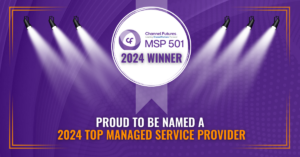Although the vast majority of businesses today use the cloud in form, many businesses continue to put off performing a full cloud migration because they’re not convinced they can do it efficiently enough for it to be worth the time, money and effort. But, this is where having a great cloud migration strategy can make all the difference in the world!
With a properly trained staff and a solid cloud migration strategy at the ready, organizations can achieve an 80% faster cloud migration process compared to those who don’t.
But this isn’t the only advantage to migrating to the cloud. Businesses who adopt a cloud infrastructure-first operational system are granted greater agility, reduced technology costs and improved efficiency across the entire organization.
With so many advantages for operating within cloud environments, it’s no wonder more businesses are choosing cloud computing as their primary method of storing and processing data.
So, to help you develop your own cloud migration strategy for a successful, first-time cloud adoption, this blog will go over the 6 main best practices for a migration plan and cloud strategy that you can use to make the most of the available cloud services currently available in the market.
Migration Tools to Know About Before Creating a Cloud Migration Strategy
1. Automation Tools
One of the key advantages to cloud computing is that it allows for automated scaling, depending on usage needs, which means your infrastructure can grow and shrink as needed without manual intervention.
To take full advantage of this flexibility, many businesses choose to automate their cloud migration processes using tools like AWS CloudFormation or Terraform from Hashicorp.
2. Application Discovery Tools
In order to thoroughly assess your current applications and data in order to determine what will be suitable for a cloud environment, it’s critical that you have access to robust application discovery tools that are able to provide detailed information about each component within the IT environments of your business. Some popular options include Gartner S2aaS, Software DNA, and Aqua.
3. Mapping Tools
Once your current IT environment has been assessed with the help of application discovery tools, you will need to map out what applications should be migrated to the cloud based on their suitability and level of availability in a cloud environment.
You can use tools like AWS CloudMap or Google Cloud Endpoints to help automate this process.
Does Putting Together a Cloud Migration Strategy Suddenly Feel Confusing?Let Advanced Networks take over and make it easy for you!
|
4. Testing and Validation Tools
Before migrating any applications or data into a new cloud environment, it is essential that you thoroughly test each component for any issues or vulnerabilities that could negatively impact performance once live in the cloud.
Some popular testing platforms include Microsoft Azure Advisor, SonarQube, and Veracode AppScan Enterprise Edition.
5. Performance Monitoring Tools
In addition to testing and validation tools, it is also important to have a robust performance monitoring tool in place within your cloud environment to help identify any potential issues or areas of improvement.
Some popular options include New Relic, AppDynamics, and Instana.
6. Security Monitoring Tools
Along with comprehensive performance monitoring capabilities, businesses must also ensure that their cloud environment is properly secured against any cyberattacks or other malicious threats that could impact their operations or data.
Popular security platforms include CloudPassage Halo, Sophos XG Firewall, and CylancePROTECT. By using the right cloud migration tools at every step of your strategy, you can be confident in achieving a successful first-time cloud migration for your business.
Comparing Different Cloud Environments Prior to Starting a Cloud Migration Strategy
When it comes to cloud computing environments, there are a number of different options that businesses can choose from based on their individual needs and preferences. Some of the most popular cloud options currently available in the market include:
1. Public Cloud
A public cloud environment is typically hosted by a third-party service provider that manages all aspects of the infrastructure for you. This option is popular with businesses that have less stringent security requirements or compliance regulations, as these providers often employ sufficient security measures on their end to mitigate any risk for your company.
2. Private Cloud
A private cloud is an internal network that provides you with direct control over your IT resources, including storage, compute power, and networking capabilities. This option is best suited for businesses that have very specific security or compliance requirements, as it gives you full access to your cloud environment and enables greater control over how data is handled.
3. Hybrid Cloud
A hybrid cloud combines elements of both a public and a private cloud in order to get the best of both worlds. This option can be useful for businesses that need additional flexibility with their IT resources while still maintaining strong security measures and regulatory compliance.
When it comes to starting a cloud migration strategy, it is important to carefully consider the different cloud environments available and select one that best aligns with your business needs and requirements. By doing so, you can ensure a successful transition to the cloud and take full advantage of its many benefits for your company’s operations.
A 6-Point Best Practice Guide to Creating a Winning Cloud Migration Strategy
Any business that has moved to the cloud has this in common: they developed a smart, workable cloud migration strategy based on the following 6 principles:
1. Establish Your Objectives and Requirements
Before you can start planning your cloud migration strategy, it is essential to clearly define your goals and desired outcomes for the process. This may include reducing costs, increasing scalability, improving efficiency, or any other business-specific goals that are important to your organization.
2. Evaluate Different Cloud Options
Once you have a clear understanding of what you hope to achieve through your cloud migration, it is important to do a thorough evaluation of the various cloud environments available in order to determine which platform would be most suitable for your needs.
Consider factors like cost, security requirements, compliance regulations, ease of use, and any other criteria that are important to you when making this decision.
|
Discover the Essential Role an MSP Can Play in Your Cloud Migration: |
3. Develop a Comprehensive Migration Plan
Once you have selected your cloud platform, the next step is to create a detailed plan for how you will migrate your data and applications to the new environment.
This should include all of the technical steps that need to be taken, from setting up infrastructure and network connections to installing software and migrating your data and existing applications.
4. Implement Rigorous Testing and Monitoring
Once your migration strategy is in place, it is essential to put strong testing and monitoring procedures in place to ensure that no issues arise during or after the transition process.
This may involve regularly checking performance metrics such as speed, uptime, and resource usage in order to detect any potential problems before they become serious issues. You may also want to consider using third-party tools to help with testing and monitoring.
5. Educate Team Members on Best Practices
In order for your cloud migration strategy to be successful, it is important to ensure that all of the relevant staff members are fully trained on how to use and manage the new environment.
This will likely involve providing training sessions or online resources to help employees get up to speed with any changes in their day-to-day workflows or account access.
6. Regularly Review and Optimize Your Strategy
Finally, it is important to stay proactive in ensuring that your cloud migration strategy remains effective over time.
This tends to include regularly reviewing metrics such as performance, compliance, and costs in order to identify areas where adjustments could be made, as well as making any necessary updates to your migration plan in response to any changes in business needs or technological advancements.
With a well-planned and executed cloud migration strategy, your business can gain all of the benefits of a flexible and efficient cloud environment while maintaining strong security, compliance, and performance.

Getting Expert MSP Help from Advance Networks to Create the Best Cloud Migration Strategy Possible
At Advance Networks, our team of expert cloud migration specialists can help you create a comprehensive and effective cloud migration strategy that best meets the needs of your business. We have extensive experience working with companies across a variety of industries, and we know exactly what it takes to ensure a smooth transition to the cloud.
Whether you’re looking for guidance on which platform to use or assistance with developing a detailed plan for migrating your data and applications, our team is here to help. We offer a full range of services including rigorous testing and monitoring, education on best practices, and ongoing optimization and review to ensure that your strategy is always up-to-date and effective.
So if you’re ready to make the switch to the cloud, contact the team at Advance Networks today and let’s get started on creating the best cloud migration strategy possible for your business.




